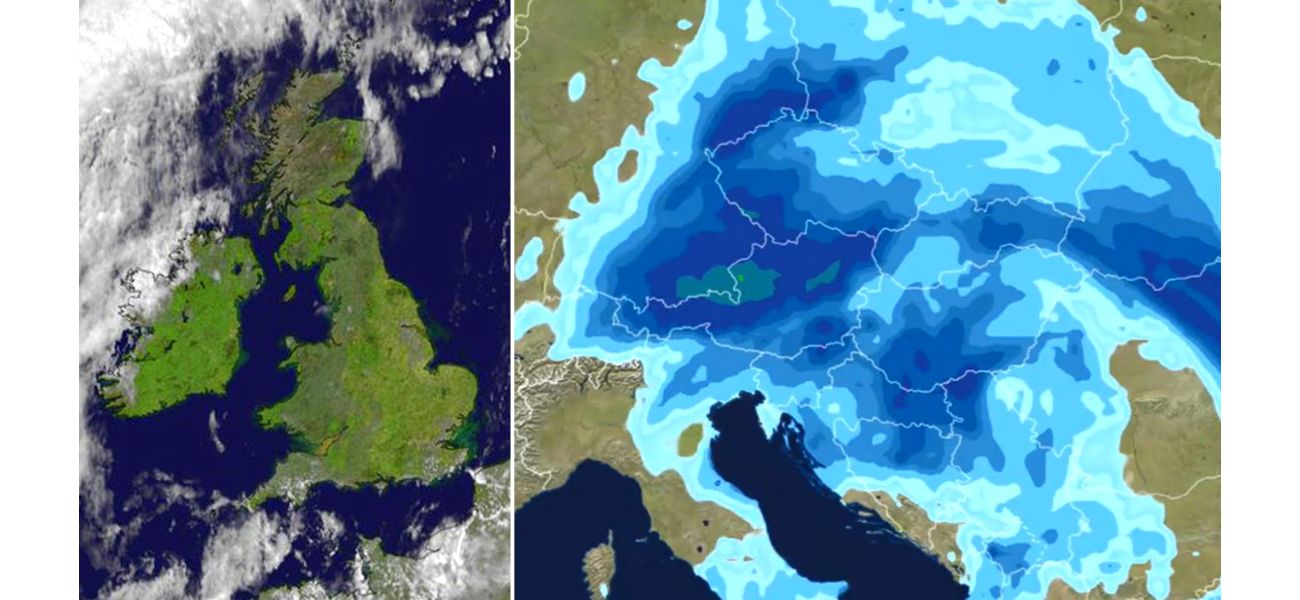Maps of UK and central Europe's weather are vastly dissimilar.
Heavy rain caused floods in Poland, Austria, and Romania, but the UK remained mostly cloudy-free.
September 17th 2024.

The weather in the UK has been quite fortunate lately, with clear skies and no rain in sight. However, our luck may soon run out as Storm Boris is headed our way. It's a stark contrast to the situation in central Europe, where heavy rains have caused devastation and loss of life.
The weather maps clearly show the stark difference between the UK and central Europe. While we bask in sunshine, countries like Poland, Austria, Romania, and Czech Republic are struggling with floods. The scenes are truly heartbreaking, with over 10,000 people evacuated and even a dam bursting. Videos have captured the terrifying sight of debris being carried by the strong currents, reaching heights of half a storey.
It's quite unusual for the UK to have such clear weather, especially after the cold snap we experienced last week. Thanks to an anticyclone above us, we are currently enjoying fine, sunny, and stable weather. It's hard to imagine the torrential downpours and destruction happening on the continent, particularly in Vienna where parts of the city are without power.
The stark contrast is evident even in satellite images, with the UK almost entirely cloud-free while central Europe is covered in rainclouds. But our luck may soon run out as Storm Boris is expected to reach us by the end of the week. Although it will have weakened, we can still expect thunderstorms in the south by Saturday. Fortunately, we are not expecting the worst of the weather, and it will soon be followed by a short period of settled weather.
The low-pressure system responsible for the downpours in central Europe has brought heavy rains from Austria to Romania. This has caused some of the worst flooding in nearly three decades, particularly in the Czech Republic and Poland. The cold weather from last week played a part in this, as the cold air from the Arctic met warm and moist air from the Mediterranean, creating the perfect conditions for a deluge.
The situation in Poland is dire, with Polish prime minister Donald Tusk declaring a state of natural disaster in the flooded areas. This will help with the evacuation and rescue efforts, as well as provide financial aid to those affected. Although the water levels have subsided, the aftermath is still evident in the debris and mud-covered streets, damaged bridges, and burst dams and embankments. Schools and offices have been forced to close, and essentials such as drinking water and food are being delivered by trucks.
The situation is not much better in Hungary, where the mayor of Budapest has warned residents of the worst floods in a decade. The Danube River is expected to breach the city's lower quays by this morning. It's a clear reminder that extreme weather events are becoming more common due to our changing climate. Warmer air can hold more moisture, resulting in heavy downpours like the ones we are currently seeing in Europe.
While the UK may seem immune to such extreme weather, we have had our fair share of flash floods and devastating storms. Last winter, floods wreaked havoc across the country, with the farming industry taking a significant hit. This year, we are expecting a rainier than average September, which could lead to another wet winter. The government is already making preparations for emergency responses, should the need arise.
The British Red Cross has reported that 1.9 million people in the UK currently live in areas at significant risk of flooding, a number that could double by the 2050s. It's a concerning statistic, and it's essential that we take proactive measures to mitigate the effects of extreme weather events. After all, as we have seen in central Europe, it only takes one storm to cause widespread devastation and loss of life.
The weather maps clearly show the stark difference between the UK and central Europe. While we bask in sunshine, countries like Poland, Austria, Romania, and Czech Republic are struggling with floods. The scenes are truly heartbreaking, with over 10,000 people evacuated and even a dam bursting. Videos have captured the terrifying sight of debris being carried by the strong currents, reaching heights of half a storey.
It's quite unusual for the UK to have such clear weather, especially after the cold snap we experienced last week. Thanks to an anticyclone above us, we are currently enjoying fine, sunny, and stable weather. It's hard to imagine the torrential downpours and destruction happening on the continent, particularly in Vienna where parts of the city are without power.
The stark contrast is evident even in satellite images, with the UK almost entirely cloud-free while central Europe is covered in rainclouds. But our luck may soon run out as Storm Boris is expected to reach us by the end of the week. Although it will have weakened, we can still expect thunderstorms in the south by Saturday. Fortunately, we are not expecting the worst of the weather, and it will soon be followed by a short period of settled weather.
The low-pressure system responsible for the downpours in central Europe has brought heavy rains from Austria to Romania. This has caused some of the worst flooding in nearly three decades, particularly in the Czech Republic and Poland. The cold weather from last week played a part in this, as the cold air from the Arctic met warm and moist air from the Mediterranean, creating the perfect conditions for a deluge.
The situation in Poland is dire, with Polish prime minister Donald Tusk declaring a state of natural disaster in the flooded areas. This will help with the evacuation and rescue efforts, as well as provide financial aid to those affected. Although the water levels have subsided, the aftermath is still evident in the debris and mud-covered streets, damaged bridges, and burst dams and embankments. Schools and offices have been forced to close, and essentials such as drinking water and food are being delivered by trucks.
The situation is not much better in Hungary, where the mayor of Budapest has warned residents of the worst floods in a decade. The Danube River is expected to breach the city's lower quays by this morning. It's a clear reminder that extreme weather events are becoming more common due to our changing climate. Warmer air can hold more moisture, resulting in heavy downpours like the ones we are currently seeing in Europe.
While the UK may seem immune to such extreme weather, we have had our fair share of flash floods and devastating storms. Last winter, floods wreaked havoc across the country, with the farming industry taking a significant hit. This year, we are expecting a rainier than average September, which could lead to another wet winter. The government is already making preparations for emergency responses, should the need arise.
The British Red Cross has reported that 1.9 million people in the UK currently live in areas at significant risk of flooding, a number that could double by the 2050s. It's a concerning statistic, and it's essential that we take proactive measures to mitigate the effects of extreme weather events. After all, as we have seen in central Europe, it only takes one storm to cause widespread devastation and loss of life.
[This article has been trending online recently and has been generated with AI. Your feed is customized.]
[Generative AI is experimental.]
0
0
Submit Comment





